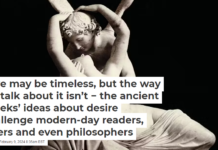

By Robert George Heath, University of Bath
This was the year the Superbowl adfest finally hit the skids. The Twitter-storm that greeted this year’s supposedly iconic ads suggests they simply didn’t work like they usually do. The Los Angeles Times’ verdict was that “social media buzzed with mostly comments expressing boredom and even backlash.”
Although a few of the ads showed satisfyingly selfish behavior – Dorito’s young man trying to put off passengers from sitting next to him was in my opinion a winner – the majority of this year’s clutch of ads were seriously selfless. It was as if the nation’s big brands had simultaneously suffered a crisis of conscience and desperately wanted the world to know that they were all decent human beings.
A lot of the vitriol was aimed at Nationwide, which featured an accidentally dead child reminiscing about the things he would never do. It’s beautiful, touching, brilliantly directed, and addresses an important problem. Super Bowl viewers hated it.
Opprobrium was also heaped on Go Daddy, whose lost puppy makes it home only to be sold. Victoria’s Secret offended feminists, Dove’s ad which praised wonderful dads was hammered for being too politically correct, the Budweiser’s ad offended microbrewers, and on and on.
Why so much displeasure, you might ask? Chris Jones of the Chicago Tribune put his finger on the problem. He’d read a book I wrote back in 2012 called Seducing the Subconscious, and here’s what he said:
Conventional wisdom has it that you can’t make someone cry without first grabbing their attention. But according to Heath, what matters most is not the level of attention … but the amount of “subconscious feeling” going on when the ad is playing. Perhaps that explains the intense backlash against last week’s suite of emotion-heavy Super Bowl advertisements. People were paying too much attention to them. And furthermore, there were too many of them. It’s a bit like sequentially watching the last two minutes of dozens of tear-jerking movies, all at once.
Please ignore this ad
This is an area I started researching at the end of the last century, publishing a monograph called The Hidden Power of Advertising in 2001. In it, I espoused a theory called Low Attention Processing, which posits that some advertising works best when people don’t pay too much attention to it
It was a message applauded by creative ad agencies, but hated in equal measure by market research companies. Low Attention Processing disturbed them because they had spent years selling metrics based on recall – how well a consumer can remember an ad – and recall works best at high attention.
Their articles and press releases proclaimed that advertising might work at low attention, but HIGH attention was best. One company even set up a website entitled “Why Robert Heath is wrong.”
Mounting evidence
For many it still is an anathema that advertising might work better if little attention is paid. But over the last 10 years, I’ve assembled a lot of evidence in support of this idea.
A dual award-winning study I carried out in 2005 showed that ad awareness does not equate to ad effectiveness. In 2006, I proved that it is the creative emotive content, not the message, in advertising I showed that drives brand favorability. And in 2009, I showed that advertising high in emotive content is actually paid LESS not more attention than advertising with low emotive content.
Advertising that lulls
The key to Low Attention Processing involves counter-argument. Positive emotion lulls us into trusting the advertiser, and since we trust them we feel there is no real need to counter-argue what they are saying. And if we don’t need to counter-argue the ad, why bother to pay attention to it?
Of course, what we don’t realize is that because emotion is processed automatically and implicitly, it needs no attention at all to be able influence us. By paying less attention, we actually allow the emotive content to be more effective at directing our brand choices. Often the most influential element in a piece of advertising is the music playing in the background, because we cannot counter-argue the effect it has on our feelings.
To some extent it doesn’t really matter what sort of emotion is in the ad, as long as it is natural, not negative, and not too obvious. What this year’s Super Bowl advertisers failed to realize, apparently, is that emotional appeals collapse when subjected to scrutiny.
Ads like the Nationwide Dead Child or the Dove Strong Dads are perceived as perceptive and honest if they ambush us half asleep late in the evening. They become cynical and manipulative when viewed by millions of wide-awake internet-connected Super Bowl viewers.
So the best way to influence emotions with advertising is to make sure no one knows that’s what you are trying to do. That’s the lesson the Super Bowl advertisers, indeed, all advertisers, need to learn.
![]()
This article was originally published on The Conversation.
Read the original article.



















